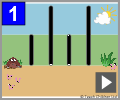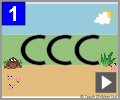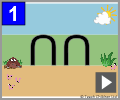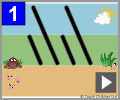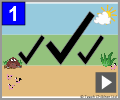Handwriting patterns - FAQs
Pre-handwriting patterns help a child to learn the shapes and directional pushes and pulls of the writing tools required to form letters. All letters are a combination of these shapes and lines. Teaching the pre-handwriting patterns in groups can make it easier, as the child can concentrate on specific directional pushes and pulls.
- Young children learn many of the directional pushes, pulls and changes in direction needed to form letters on a much larger scale, long before they pick up a pencil, through playing with cars or pretending to cook. Play these games
- The age at which to start a more formal approach to teaching handwriting patterns varies and is dependent on your child's fine motor skills ability. Some children can be taught from 4 years old while others may be 5 or 6 years old.
- Make pattern sessions short and sweet. If you try to make them too long a child will become bored and reluctant to do more. As their confidence and skills improve so will the amount of time they are happy to spend learning and practising their patterns.
- In the early stages of learning to form pre-handwriting patterns use a range of pencils, chalks, crayons and paints on both vertical and horizontal surfaces. The important thing is to show, and talk through with, your child how to make the patterns using the correct directional movements.
- Once your child is able to create the patterns on plain paper at a size that is close to our free Level 0 Worksheets they are ready to progress to these.
- As your child's pattern size reduces move to the next lined height paper - don't try to jump too quickly as your child will not be ready and this could put them off.
- Teach the patterns in the following order:
- Straights: 1 to 6
- Curves: 1 to 8
- Tunnels: 1 to 6
- Diagonals: 1 to 8
- Straights: 7 to 9
- Curves: 9 to 16
- Tunnels: 7 to 10
- Diagonals: 9 to 14
- Joins: 1 to 9
- Alternatively you can start with patterns your child is already starting to use in their scribbles and drawings, as it will build their confidence and encourage them to try harder patterns later.
- With young and pre-school children you don't want to restrict the size of their movements. Large sheets of plain paper or large chalk boards are best.
- Once they can form the patterns at close to our free Level 0 Worksheets line height they are ready to start using these.
- For older children plain lined paper can be used but make sure the line height is right for your child.
Once the pre-handwriting patterns have been mastered a child will have the skill base necessary, and be more confident, to form letters, numbers and symbols.
At this stage size is not important. If your child can draw the pre-handwriting patterns accurately they are ready to move on to letters. As their gross and fine motor skills develop their writing will get smaller.


